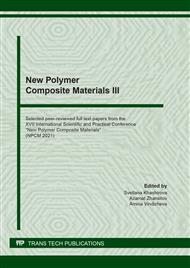[1]
S. Chen, Y. Li, L. Xie, et al., Thermosensitive chitosan-collagen composite hydrogel loaded with basic fibroblast growth factor retards ventricular remodeling after myocardial infarction in mice, Chin. J. Tissue Eng. Res. 25 (2021) 2472-2478.
Google Scholar
[2]
M. Nosenko, A.M. Moysenovich, A. Arkhipova, et al., Fibroblasts upregulate expression of adhesion molecules and promote lymphocyte retention in 3D fibroin/gelatin scaffolds, Bioact. Mater. 6 (2021) 3449-3460.
DOI: 10.1016/j.bioactmat.2021.03.016
Google Scholar
[3]
Egorikhina M.N., Aleinik D.Ya., Rubtsova Yu.P., et al., Hydrogel scffolds based on blood plasma cryoprecipitate and collagen derived from various sources: Structural, mechanical and biological characteristics, Bioact. Mater. 4 (2019) 334-345.
DOI: 10.1016/j.bioactmat.2019.10.003
Google Scholar
[4]
V.M. Oliveira, C.R. Assis, B.A.M. Costa, et al., Physical, biochemical, densitometric and spectroscopictechniques for characterization collagen from alternative sources: A review based on the sustainable valorization of aquatic by-products, J. Mol. Struct. 1224 (2021) 129023.
DOI: 10.1016/j.molstruc.2020.129023
Google Scholar
[5]
M. Toledano, M. Toledano-Osorio, A. Carrasco-Carmona, et al., State of the art on biomaterials for soft tissue augmentation in the oral cavity. Part I: Natural polymers-based biomaterials, Polymers, 12 (2020) 1850.
DOI: 10.3390/polym12081850
Google Scholar
[6]
A.A. Ivanov, O.P. Popova, T.I. Danilova, et al., Strategies of the selection and use scaffolds in bioengineering, Biol. Bul. Rev.139 (2019) 196–205.
Google Scholar
[7]
H.-J. Jiang, J. Xu, Z.-Y. Qiu, et al., Mechanical properties and cytocompatibility improvement of vertebroplasty PMMA bone cements by incorporating mineralized collagen, Mater. 8 (2015) 2616-2634.
DOI: 10.3390/ma8052616
Google Scholar
[8]
M. Vedhanayagam, S. Ananda, B.U. Nair, et al., Polymethyl methacrylate (PMMA) grafted collagen scaffold reinforced by PdO-TiO2 nanocomposites, Mater. Sci. Eng., C. (2019) 110378.
DOI: 10.1016/j.msec.2019.110378
Google Scholar
[9]
B. Carrion, M.F. Souzanchi, V.T. Wang, et al., The synergistic effects of matrix stiffness and composition on the response of chondroprogenitor cells in a 3D precondensation microenvironment, Adv. Healthcare Mater. 5 (2016) 1192-1202.
DOI: 10.1002/adhm.201501017
Google Scholar
[10]
J.L.A. Del Barrio, F. Arnalich-Montiel, M. Chiesa, et al., Biointegration of corneal macroporous membranes based on poly(ethyl acrylate) copolymers in an experiental animal model, J. Biomed. Mater. Res., Part A. 103 (2015) 1106-1118.
DOI: 10.1002/jbm.a.35249
Google Scholar
[11]
V. Perez‐Puyana, P. Wieringa, Ya. Yuste, et al., Fabrication of hybrid scaffolds obtained from combinations of PCL with gelatin or collagen via electrospinning for skeletal muscle tissue engineering, J. Biomed. Mater. Res. (2021) 1–13.
DOI: 10.1002/jbm.a.37156
Google Scholar
[12]
S. Fujisawa, Y. Kadoma, Tri-n-butylborane/water complex-mediated copolymerization of methyl methacrylate with proteinaceous materials and proteins: A Review, Polymers. 2 (2010) 575-595.
DOI: 10.3390/polym2040575
Google Scholar
[13]
Y.L. Kuznetsova, E.A. Morozova, A.S. Vavilova, et al., Synthesis of biodegradable grafted copolymers of gelatin and polymethyl methacrylate, Polym. Sci., Ser. D. 13 (2020) 453-459.
DOI: 10.1134/s1995421220040115
Google Scholar
[14]
Y.L. Kuznetsova, K.S. Sustaeva, A.S. Vavilova, et al., Tributylborane in the synthesis of graft-copolymers of gelatin and acrylamide, J. Organomet. Chem. 924 (2020) 121431.
DOI: 10.1016/j.jorganchem.2020.121431
Google Scholar
[15]
L.L Semenycheva, V.O. Chasova, D.G. Fukina, A.V. Koryagin, N.B. Valetova, E.V. Suleimanov, Synthesis of polymethyl methacrylate–collagen graft copolymer using a photocatalyst - complex oxide RbTe1.5W0.5O6, Polym. Sci., Ser. D. 7 (2021) (sent to the press).
DOI: 10.1134/s1995421222010166
Google Scholar
[16]
L.L. Semenycheva, J.L. Kuznetsova, N.B. Valetova, E.V. Geras'kina, O.A. Tarankova, Method for producing of acetic dispersion of high molecular fish collagen. RF. Patent 2,567,171. (2015).
Google Scholar
[17]
D.G. Fukina, E.V. Suleimanov, G.K. Fukin, A.V. Boryakov, S.Y. Zubkov, L.A. Istomin, Crystal structure features of the mixed-valence tellurium β-pyrochlores: CsTe1.625W0.375O6 and RbTe1.5W0.5O6, J. Solid State Chem. 286 (2020) 121276.
DOI: 10.1016/j.jssc.2020.121267
Google Scholar
[18]
G. Zengin, A.C.A. Zengin, E. Kılıc, et al., Characterization of collagen derived products prepared by use of alkali and dairy by-product, Environ. Eng. Manage. J. 18 (2019) 2355-2362.
DOI: 10.30638/eemj.2019.224
Google Scholar


